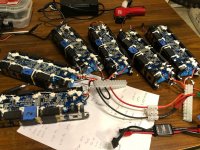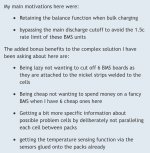ichiban
100 W
Let's say if we need to make a replacement lithium battery pack for existing lead-acid, mid-size 1.5-ton forklift (48V, 450Ah or more) then we will need a high current BMS to take care of our batt pack. Since high current BMS is harder to find, fewer choices, and might be at risk if we depend only on a single BMS for the whole big pack. Of course, 1 BMS is easier to handle, lower cost and all that. But, since there are plenty of smaller 100-200 Amp BMSs available in the market, it might be more versatile to put multiple batt modules together with multiple BMSs to handle the job.
Existing system : 1.5-ton forklift
Working Ah for an average mid-size forklift =
430A max for drive motor (with brake fully engaged), and,
250A max for lift motor (with brake fully engaged = max load to lift)
Max of the max = 430A+250A = 680A but this figure rarely occurs.
Standard deep-discharge lead-acid batt pack = 48V, 435Ah (5hrs).
I would assume that max current is 600A. Average working current is 300-400A.
So, a BMS or BMSs capable of handling 800-Amp is considered.
I am thinking of ...
Single line diagrams form for ease :
![ATTACH]](/sphere/proxy.php?image=http%3A%2F%2F%5BATTACH+type%3D%22full%22+alt%3D%22136547.jpg%22%5D0%5B%2FATTACH%5D&hash=d092878112cf273586136500f5b0dfb7)
Per diagram #1) Modular battery system : Cells and BMSs together are pre-fab as a module. Common BMSs outputs, common charge ports are to be connected once a module is plugged to the system.
By doing this, modules (with BMSs) can be easily added to expand capacities. Different capacity (Ah) of modules can be mixed. Higher cost and complexity from extra BMS, wires & connections.
Per diagram #2) Single BMS / multiple batts modules : Simpler, but limited by capacity of the single BMS. Each serial groups of all the packs are connected. For examples, 1S of module 1, 2, 3, and ... are connected. 2S of module 1, 2, 3, and ... are connected. and vice versa. Voltage of each serial group and the whole module must be very close before plugging in a new module. All
Each module : IMO should be 40-50Ah / module nominal
Depending on cells type, capacities, chemistry and etc., expected size of each module is
For cylindrical cells :
14S10P (cylindrical Li-Ion, from 18650 & up) - lots of spot-welds to make, OR
15S or 16S10P (cylindrical LiFePO4 from 18650 & up) - also lots of spot-welds to make.
OR
For prismatic cells :
15S or 16S2P or 16S4P (prismatic LiFePO4, 240Ah or 120Ah cells) - easy to assemble but less energy density, higher cost.
Bluetooth connections :
It is nice to have a remote acquisition of batt modules/pack status. But I seriously prefer a much longer monitoring range than that 5 to 10-meter range of bluetooth. It bothers me every time when I want to check my e-bike pack status that I have to walk up to the bike. Via IP ?
Charger :
In this particular circumstance, a power charger is needed, something starting at 10-20kW, 48V, CC-CV to charge all of the modules at once via BMS(s). May be 200 to 400-Amp charging current. I think it is better this way than using smaller chargers to charge individual modules.
Questions :
1) What would the expert say about above designs for both diagram #1 and #2 ?
2) What are the downsides of each design, if any ?
3) What is the max number of BMSs that can be paralleled ? Only applicable to diagram #1.
4) How many bluetooth connections can we connect to a single user device ? Let's say that we have 12 batt modules (with 12 BMSs) connected together to make a batt pack. Will all of the BMSs be able to connect and display each individual module status simultaneously ? This might be a drawback, since we have to sum-up all of each module data to obtain the whole pack working log. Is there any easy way to combine them altogether to get 1 complete report ?
5) Any longer range batt pack status monitoring system ? For me, bluetooth is too limited. Anyone know/experience of any internet-based monitoring system ?
6) By using 1 big charger to charge all of the modules at once, some module might be charged faster than others. Voltage of each serial group (or whole module) can be different. Can different % SOC modules be plugged-in together, for both diagram 1 and diagram 2 ? This is to rest assure that risk is not there for us to take. Is it safer by design of the system ?
7) OR some more appropriate designs might be better/safer than #1 & #2 above ?
Any productive comments from anyone are welcome and appreciated.
Existing system : 1.5-ton forklift
Working Ah for an average mid-size forklift =
430A max for drive motor (with brake fully engaged), and,
250A max for lift motor (with brake fully engaged = max load to lift)
Max of the max = 430A+250A = 680A but this figure rarely occurs.
Standard deep-discharge lead-acid batt pack = 48V, 435Ah (5hrs).
I would assume that max current is 600A. Average working current is 300-400A.
So, a BMS or BMSs capable of handling 800-Amp is considered.
I am thinking of ...
Single line diagrams form for ease :
![ATTACH]](/sphere/proxy.php?image=http%3A%2F%2F%5BATTACH+type%3D%22full%22+alt%3D%22136547.jpg%22%5D0%5B%2FATTACH%5D&hash=d092878112cf273586136500f5b0dfb7)
Per diagram #1) Modular battery system : Cells and BMSs together are pre-fab as a module. Common BMSs outputs, common charge ports are to be connected once a module is plugged to the system.
By doing this, modules (with BMSs) can be easily added to expand capacities. Different capacity (Ah) of modules can be mixed. Higher cost and complexity from extra BMS, wires & connections.
Per diagram #2) Single BMS / multiple batts modules : Simpler, but limited by capacity of the single BMS. Each serial groups of all the packs are connected. For examples, 1S of module 1, 2, 3, and ... are connected. 2S of module 1, 2, 3, and ... are connected. and vice versa. Voltage of each serial group and the whole module must be very close before plugging in a new module. All
Each module : IMO should be 40-50Ah / module nominal
Depending on cells type, capacities, chemistry and etc., expected size of each module is
For cylindrical cells :
14S10P (cylindrical Li-Ion, from 18650 & up) - lots of spot-welds to make, OR
15S or 16S10P (cylindrical LiFePO4 from 18650 & up) - also lots of spot-welds to make.
OR
For prismatic cells :
15S or 16S2P or 16S4P (prismatic LiFePO4, 240Ah or 120Ah cells) - easy to assemble but less energy density, higher cost.
Bluetooth connections :
It is nice to have a remote acquisition of batt modules/pack status. But I seriously prefer a much longer monitoring range than that 5 to 10-meter range of bluetooth. It bothers me every time when I want to check my e-bike pack status that I have to walk up to the bike. Via IP ?
Charger :
In this particular circumstance, a power charger is needed, something starting at 10-20kW, 48V, CC-CV to charge all of the modules at once via BMS(s). May be 200 to 400-Amp charging current. I think it is better this way than using smaller chargers to charge individual modules.
Questions :
1) What would the expert say about above designs for both diagram #1 and #2 ?
2) What are the downsides of each design, if any ?
3) What is the max number of BMSs that can be paralleled ? Only applicable to diagram #1.
4) How many bluetooth connections can we connect to a single user device ? Let's say that we have 12 batt modules (with 12 BMSs) connected together to make a batt pack. Will all of the BMSs be able to connect and display each individual module status simultaneously ? This might be a drawback, since we have to sum-up all of each module data to obtain the whole pack working log. Is there any easy way to combine them altogether to get 1 complete report ?
5) Any longer range batt pack status monitoring system ? For me, bluetooth is too limited. Anyone know/experience of any internet-based monitoring system ?
6) By using 1 big charger to charge all of the modules at once, some module might be charged faster than others. Voltage of each serial group (or whole module) can be different. Can different % SOC modules be plugged-in together, for both diagram 1 and diagram 2 ? This is to rest assure that risk is not there for us to take. Is it safer by design of the system ?
7) OR some more appropriate designs might be better/safer than #1 & #2 above ?
Any productive comments from anyone are welcome and appreciated.



